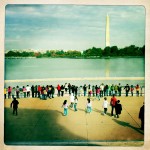(This article originally appeared on cnn.com.)
Should your zip code determine your access to the American dream? Or is the U.S. Constitution’s guarantee to provide “equal protection” a principle we have silently agreed to uphold in theory – but not in practice?
I’m starting to wonder after reading about Tanya McDowell, the Connecticut mother facing felony charges for lying on her five-year-old son’s registration forms so he could attend a better school. McDowell’s story is painfully reminiscent of Kelley Williams-Bolar, the Ohio mother who made a similar choice earlier this year – and is now a convicted felon.
These two stories of civil disobedience come against the backdrop of an ongoing national conversation about our public school system – and how it must be improved. They also provide an unsettling irony in lieu of tomorrow’s 57th anniversary of Thurgood Marshall’s historic victory in Brown v. Board of Education, the 1954 U.S. Supreme Court decision that triumphantly reaffirmed a core American principle: “In the field of public education the doctrine of ‘separate but equal’ has no place.”
If Marshall were alive today, he would urge us to stop celebrating our symbolic victory in Brown, and start accepting our actual responsibility for tolerating a public education system that is, clearly, still separate, and still unequal.
Marshall said so himself, in a lesser known 1973 Court opinion, San Antonio v. Rodriguez. But this time he was not the lead lawyer, arguing the case, but the Court’s first African-American justice, issuing a ruling. And this time, he was on the losing side.
The case began when a group of poor Texas parents claimed that their state’s tolerance of the wide disparity in school resources – much of which were determined by the value of local property taxes – violated the Equal Protection Clause of the 14th Amendment. A state court agreed, but the U.S. Supreme Court, in a narrow 5-4 decision, reversed.
Gone from the Court’s 1973 ruling was its 1954 contention that “education is perhaps the most important function of state and local governments.” Gone, too, was its assertion that “it is doubtful any child may reasonably be expected to succeed in life if he is denied the opportunity of an education. Such an opportunity,” wrote a unanimous Court in Brown, “where the state has undertaken to provide it, is a right which must be made available to all on equal terms.”
Instead, the five-Justice majority in Rodriguez wrote simply that while the Texas school system “can fairly be described as chaotic and unjust . . . it does not follow that this system violates the Constitution.”
“Though education is one of the most important services performed by the state, it is not within the limited category of rights recognized by this Court as guaranteed by the Constitution.” If it were, the majority conceded, “virtually every State will not pass muster.”
For Justice Marshall, that was precisely the point. “The Court concludes that public education is not constitutionally guaranteed,” he wrote, even though “no other state function is so uniformly recognized as an essential element of our society’s well being.”
Marshall understood that without equal access to a high-quality public education, democracy doesn’t work. “Education directly affects the ability of a child to exercise his First Amendment rights,” he explained. “Education prepares individuals to be self-reliant and self-sufficient participants in society. Both facets of this observation are suggestive of the substantial relationship which education bears to guarantees of our Constitution.”
So here we are, nearly thirty years after Rodriguez – and nearly sixty after Brown – and yet parents like Tanya McDowell and Kelley Williams-Bolar feel compelled to break the law to ensure that their children receive a fair shot at the American dream. Meanwhile, income inequality has reached unprecedented levels, the nation has simultaneously grown more racially and ethnically diverse, and massive spending disparities remain between schools.
In today’s America, when it comes to public education, have we allowed our five-digit zip codes to become the equivalent of a lottery ticket to a better future? Is this really who we wish to be?
After so many years and so little real change, something new – perhaps even something drastic – needs to be done.
What if we took away the legal ambiguity that resulted in a 5-4 Supreme Court decision? What if we made the guarantee of an equal opportunity to learn our nation’s 28th Constitutional Amendment?
What do YOU think? Is a Free Education a Fundamental Right?
a) NO. A public education is extremely important. It’s also not listed as a fundamental right anywhere in the U.S. Constitution. It may be imperfect, but the Supreme Court got it right in the Rodriguez case.
b) YES. The 14th Amendment’s guarantee of “equal protection” under the laws is sufficient grounds for recognizing the unique value of a quality education. It’s time to reinterpret the Rodriguez case!
c) NOT YET. Reinterpreting Rodriguez is not enough. It’s time to make equal access to a quality education an undeniable right. It’s time for the 28th Amendment to the U.S. Constitution!




Recent Comments